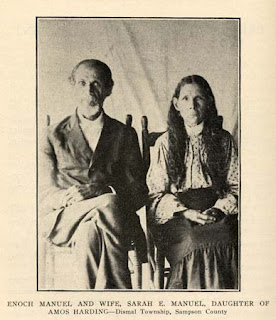
Enoch Manuel andnuel - Coharie - 1916. his wife, Sarah E. Ma
The Coharie ("Schohari"), which means "Driftwood" in Tuscarora, are a Native American Tribe who descend from the Carolina Iroquoian Tuscarora nation. They are located chiefly on the Little Coharie River, in Sampson and Harnett counties in North Carolina. The Coharie are one of eight state-recognized Native American tribes in North Carolina.
The state of North Carolina recognized the Coharie Tribe in 1971. Clinton, North Carolina is the tribal seat. In 1975, the tribe chartered the Coharie Intra-Tribal Council to serve as a private non-profit organization established to promote the health, education, social, and economic well-being of the Native people of Sampson and Harnett Counties.
The Coharie Intra-Tribal Council is housed in the old Eastern Carolina Indian School building, a school that served the Native Americans of Sampson, Harnett, Cumberland, Columbus, Person, and Hoke counties from 1942 until 1966. At that time, the 1964 federal Civil Rights Act had ended legal racial segregation of public schools.
The Coharie Indian Tribe elected their first tribal chief in 1910. Tribal affairs are led by a tribal chief and seven tribal council members. The Coharie political leadership oversees the four communities of Coharie Indians from three geographical locations in Sampson County and one region in Harnett County.
When European explorers arrived in what is now North Carolina, American Indians already had long-established ways of organizing and governing their communities. Colonization forced most tribes to give up their lands and abandon their ways of life. Since the 1800's, many tribes have reunited and recovered their heritage. They have fought — and are still fighting — for respect, recognition, and the right to govern themselves.
The Coharie Tribe has a tribal governing body. The governing bodies consist of two boards. The Coharie People Board is a governing body elected by the tribal community. This board oversees the tribal functions and the tribal office building. Tribal functions include the annual powwow in September and the annual Coharie Princess Pageant in July. The board consists of nine people. This board has a chairman, vice chair, secretary, treasurer, and members. From this board, three members are voted and agreed upon to go to the Coharie Intra-tribal Council board. This board oversees and governs all the finances, (e.g. grants), petitions for federal recognition, tribal enrollment, staffing, and other executive duties. This board consists of an elected chairman, vice chair, secretary, and members. The tribe also has an elected tribal chief whose duties are mainly of traditional stature (e.g. naming ceremonies, blessing of powwow arena, representing the tribe at other tribal and statewide functions).
Historians generally contend that the Coharie are descendants of the Iroquoian-speaking Neusiok and Coree, as well as the Iroquoian Tuscarora, and the Siouan Waccamaw, who occupied what is now the central portion of North Carolina. In the early seventeenth century, the Coree lived along the Big Coharie and the Little Coharie Rivers in present-day Sampson County.
Between 1730 and 1745, inter-tribal conflicts as well as competition over land and resources between Native peoples and English colonials caused numerous wars. The trade in deer skins and Indians found some tribes capturing members of traditional enemy tribes to sell as slaves to the colonists. In addition, Eurasian infectious diseases such as measles and smallpox, to which the Natives had no natural immunity, decimated many communities. The epidemics disrupted their societies.
Throughout the 1800s, the Coharie built their community in Sampson County. The Coharie held the right under state law to own and use firearms, and vote in local elections. But, the 1830's brought events that reduced their civil rights. The federal Indian removal policy of the 1830's forced tribes from the east to move west of the Mississippi River. More significantly, following Nat Turner's slave rebellion of 1831, the state passed legislation on 1835 reducing the rights of non White people. They lost their right to vote and bear arms. The Convention of 1868 removed the ban.
In 1859, the Coharie established their own subscription school. In 1910, the Coharie established an Indian school in Dismal Township. In 1911, the Coharie established New Bethel Indian School. In 1943, the state of North Carolina established and built East Carolina Indian School, the first primary through high school Indian school, in Herring Township in Sampson County.*
MEN
Kin 35: Blue Solar Eagle
I pulse in order to create
Realizing mind
I seal the output of vision
With the solar tone of intention
I am guided by the power of magic.
It is the property of a divine intellect to be always intently thinking about the beautiful.*
*Star Traveler's 13 Moon Almanac of Synchronicity, Galactic Research Institute, Law of Time Press, Ashland, Oregon, 2016-2017.
The Sacred Tzolk'in
Anahata Chakra (Silio Plasma)





No comments:
Post a Comment